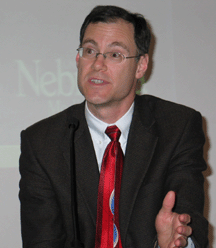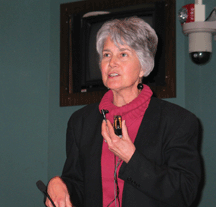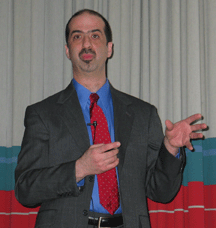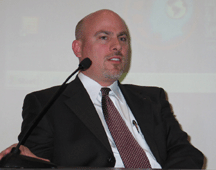 |
Bill Lydiatt, M.D. |
Head and neck cancer strikes about 200 Nebraskans and 400 Iowans each year. Although the numbers aren’t that large, the devastation that it causes to patients and their families is certainly significant.
Over the course of history, many well known people have had head and neck cancer. Among the most prominent are the famous psychiatrist, Dr. Sigmund Freud, and President Grover Cleveland, who both had cancer of the palate, and Beatle George Harrison, who had cancer of the larynx.
Last week, in conjunction with the “Saving Faces: Art and Medicine” art exhibit now at the University of Nebraska at Omaha Art Gallery, more than 100 people attended a panel discussion on head and neck cancer at the Eppley Science Hall Amphitheater.
 |
Virginia Aita, Ph.D. |
Head and neck cancer occurs in males twice as often as it does in females, Dr. Lydiatt said, and victims of head and neck cancer are tobacco and alcohol users in 80 to 90 percent of cases.
|
Following Kooser, the final two speakers in the series and their topics will be:
The art exhibition features 42 portraits by Gilbert showing patients with head and neck cancer, trauma and congenital lesions at various stages of their treatment. It will be at the UNO Art Gallery through Feb. 24. The UNO Art Gallery, which is located on the north end of the Weber Fine Arts Building, is open: noon to 4 p.m. on Tuesdays, Wednesdays and Fridays; noon to 8 p.m. on Thursdays; and 2 to 5 p.m. on Sundays. It is closed on Saturdays and Mondays. The Saving Faces art exhibition/speaker series is a cooperative project between UNMC and UNO. |
Treatment of head and neck cancer patients is a multidisciplinary team effort, Dr. Lydiatt said, including a variety of specialty physicians and dentists, nurses, speech pathologists, mental health professionals and others. Fortunately, thanks to advances in medical treatments – especially with plastic and reconstructive surgery techniques – amazing things can be done to help head and neck cancer patients.
“You have to give them hope,” Dr. Salinas said. “If they don’t have the will to go along with the treatment, you won’t be successful.”
Dr. Johnson added: “You have to make sure the patient has realistic expectations of what we can do. The worse thing is to sell something that you can’t deliver.”
At the same time, Dr. Lydiatt said, “You must be as honest as possible.”
Patients undergoing plastic and reconstructive surgery for head and neck cancer always wonder, “When are we going to put the plastic in?” Dr. Salinas said.
In actuality, Dr. Johnson said plastic surgery has nothing to do with plastic. The term comes from the Greek word plastikos, which means to change or to mold.
Plastic surgeons now use a variety of synthetic materials, such as titanium, mesh, artificial bone and bone paste, to reconstruct facial features. When cancer occurs in the jaw, part of the patient’s lower leg bone, the fibula, is harvested with its own blood vessels, which are then connected to blood vessels in the neck and the bone is used to rebuild the jaw. In many cases, skin tissue is taken from another part of the body and used to fill in areas where cancer has occurred.
 |
Tom Salinas, D.D.S. |
The presenters showed fascinating slides depicting before and after photos of head and neck cancer patients. They showed how replacement noses, eyes and ears are made and anchored to the face with craniofacial implants. These implants are made with titanium and adhere to existing bone structures.
With the use of magnets, patients can literally take these artificial body parts on and off, and they will always be perfectly aligned.
“It’s a process,” Dr. Lydiatt said, “and it’s different for every person.”
He noted that depression is especially common among head and neck cancer patients, and UNMC is doing a study looking at this issue.
The panel discussion concluded with questions from the audience. The final words came from a gentleman wearing a Kansas State sweater. He didn’t have a question, but rather wanted to let the audience know what a great head and neck cancer team UNMC has.
 |
Perry Johnson, M.D. |
A faculty member at Kansas State, he decided to leave Kansas and come to Omaha for his treatment. He thanked the team for “saving my life.”